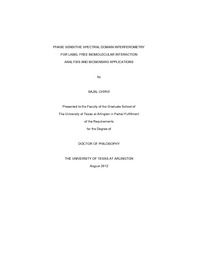
ATTENTION: The works hosted here are being migrated to a new repository that will consolidate resources, improve discoverability, and better show UTA's research impact on the global community. We will update authors as the migration progresses. Please see MavMatrix for more information.
Show simple item record
| dc.contributor.author | Chirvi, Sajal | en_US |
| dc.date.accessioned | 2013-03-20T19:12:00Z | |
| dc.date.available | 2013-03-20T19:12:00Z | |
| dc.date.issued | 2013-03-20 | |
| dc.date.submitted | January 2012 | en_US |
| dc.identifier.other | DISS-11852 | en_US |
| dc.identifier.uri | http://hdl.handle.net/10106/11574 | |
| dc.description.abstract | Biomolecular interaction analysis (BIA) plays vital role in wide variety of fields, which include biomedical research, pharmaceutical industry, medical diagnostics, and biotechnology industry. Study and quantification of interactions between natural biomolecules (proteins, enzymes, DNA) and artificially synthesized molecules (drugs) is routinely done using various labeled and label-free BIA techniques. Labeled BIA (Chemiluminescence, Fluorescence, Radioactive) techniques suffer from steric hindrance of labels on interaction site, difficulty of attaching labels to molecules, higher cost and time of assay development. Label free techniques with real time detection capabilities have demonstrated advantages over traditional labeled techniques. The gold standard for label free BIA is surface Plasmon resonance (SPR) that detects and quantifies the changes in refractive index of the ligand-analyte complex molecule with high sensitivity. Although SPR is a highly sensitive BIA technique, it requires custom-made sensor chips and is not well suited for highly multiplexed BIA required in high throughput applications. Moreover implementation of SPR on various biosensing platforms is limited.In this research work spectral domain phase sensitive interferometry (SD-PSI) has been developed for label-free BIA and biosensing applications to address limitations of SPR and other label free techniques. One distinct advantage of SD-PSI compared to other label-free techniques is that it does not require use of custom fabricated biosensor substrates. Laboratory grade, off-the-shelf glass or plastic substrates of suitable thickness with proper surface functionalization are used as biosensor chips. SD-PSI is tested on four separate BIA and biosensing platforms, which include multi-well plate, flow cell, fiber probe with integrated optics and fiber tip biosensor. Sensitivity of 33 ng/ml for anti-IgG is achieved using multi-well platform. Principle of coherence multiplexing for multi-channel label-free biosensing applications is introduced. Simultaneous interrogation of multiple biosensors is achievable with a single spectral domain phase sensitive interferometer by coding the individual sensograms in coherence-multiplexed channels. Experimental results demonstrating multiplexed quantitative biomolecular interaction analysis of antibodies binding to antigen coated functionalized biosensor chip surfaces on different platforms are presented. | en_US |
| dc.description.sponsorship | Dave, Digant P. | en_US |
| dc.language.iso | en | en_US |
| dc.publisher | Biomedical Engineering | en_US |
| dc.title | Phase Sensitive Spectral Domain Interferometry For Label Free Biomolecular Interaction Analysis And Biosensing Applications | en_US |
| dc.type | Ph.D. | en_US |
| dc.contributor.committeeChair | Dave, Digant P. | en_US |
| dc.degree.department | Biomedical Engineering | en_US |
| dc.degree.discipline | Biomedical Engineering | en_US |
| dc.degree.grantor | University of Texas at Arlington | en_US |
| dc.degree.level | doctoral | en_US |
| dc.degree.name | Ph.D. | en_US |
Files in this item
- Name:
- Chirvi_uta_2502D_11852.pdf
- Size:
- 5.838Mb
- Format:
- PDF
This item appears in the following Collection(s)
Show simple item record


